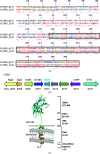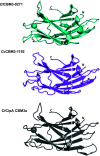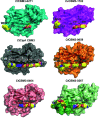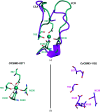Novel clostridial cell-surface hemicellulose-binding CBM3 proteins
- PMID: 33830074
- PMCID: PMC8034430
- DOI: 10.1107/S2053230X21002764
Novel clostridial cell-surface hemicellulose-binding CBM3 proteins
Abstract
A novel member of the family 3 carbohydrate-binding modules (CBM3s) is encoded by a gene (Cthe_0271) in Clostridium thermocellum which is the most highly expressed gene in the bacterium during its growth on several types of biomass substrates. Surprisingly, CtCBM3-0271 binds to at least two different types of xylan, instead of the common binding of CBM3s to cellulosic substrates. CtCBM3-0271 was crystallized and its three-dimensional structure was solved and refined to a resolution of 1.8 Å. In order to learn more about the role of this type of CBM3, a comparative study with its orthologue from Clostridium clariflavum (encoded by the Clocl_1192 gene) was performed, and the three-dimensional structure of CcCBM3-1192 was determined to 1.6 Å resolution. Carbohydrate binding by CcCBM3-1192 was found to be similar to that by CtCBM3-0271; both exhibited binding to xylan rather than to cellulose. Comparative structural analysis of the two CBM3s provided a clear functional correlation of structure and binding, in which the two CBM3s lack the required number of binding residues in their cellulose-binding strips and thus lack cellulose-binding capabilities. This is an enigma, as CtCBM3-0271 was reported to be a highly expressed protein when the bacterium was grown on cellulose. An additional unexpected finding was that CcCBM3-1192 does not contain the calcium ion that was considered to play a structural stabilizing role in the CBM3 family. Despite the lack of calcium, the five residues that form the calcium-binding site are conserved. The absence of calcium results in conformational changes in two loops of the CcCBM3-1192 structure. In this context, superposition of the non-calcium-binding CcCBM3-1192 with CtCBM3-0271 and other calcium-binding CBM3s reveals a much broader two-loop region in the former compared with CtCBM3-0271.
Keywords: CBM; Clostridium clariflavum; Clostridium thermocellum; calcium binding; cellulosome; crystal structure.
Figures





Similar articles
-
Fine-structural variance of family 3 carbohydrate-binding modules as extracellular biomass-sensing components of Clostridium thermocellum anti-σI factors.Acta Crystallogr D Biol Crystallogr. 2014 Feb;70(Pt 2):522-34. doi: 10.1107/S139900471302926X. Epub 2014 Jan 31. Acta Crystallogr D Biol Crystallogr. 2014. PMID: 24531486
-
Structure of a family 3b' carbohydrate-binding module from the Cel9V glycoside hydrolase from Clostridium thermocellum: structural diversity and implications for carbohydrate binding.Acta Crystallogr D Biol Crystallogr. 2010 Jan;66(Pt 1):33-43. doi: 10.1107/S0907444909043030. Epub 2009 Dec 21. Acta Crystallogr D Biol Crystallogr. 2010. PMID: 20057047
-
Interactions between family 3 carbohydrate binding modules (CBMs) and cellulosomal linker peptides.Methods Enzymol. 2012;510:247-59. doi: 10.1016/B978-0-12-415931-0.00013-6. Methods Enzymol. 2012. PMID: 22608730
-
A single mutation reforms the binding activity of an adhesion-deficient family 3 carbohydrate-binding module.Acta Crystallogr D Biol Crystallogr. 2012 Jul;68(Pt 7):819-28. doi: 10.1107/S0907444912013133. Epub 2012 Jun 15. Acta Crystallogr D Biol Crystallogr. 2012. PMID: 22751667
-
Distinctive ligand-binding specificities of tandem PA14 biomass-sensory elements from Clostridium thermocellum and Clostridium clariflavum.Proteins. 2019 Nov;87(11):917-930. doi: 10.1002/prot.25753. Epub 2019 Jun 25. Proteins. 2019. PMID: 31162722 Free PMC article.
Cited by
-
Cellulolytic and hemicellulolytic capacity of Acetivibrio clariflavus.Appl Microbiol Biotechnol. 2025 Apr 28;109(1):105. doi: 10.1007/s00253-025-13471-9. Appl Microbiol Biotechnol. 2025. PMID: 40295343 Free PMC article. Review.
-
Purified fibers in chemically defined synthetic diets destabilize the gut microbiome of an omnivorous insect model.Front Microbiomes. 2024;3:1477521. doi: 10.3389/frmbi.2024.1477521. Epub 2024 Dec 11. Front Microbiomes. 2024. PMID: 40114931 Free PMC article.
References
-
- Bayer, E. A., Shimon, L. J. W., Shoham, Y. & Lamed, R. (1998). J. Struct. Biol. 124, 221–234. - PubMed
-
- Bellapadrona, G., Chiaraluce, R., Consalvi, V., Ilari, A., Stefanini, S. & Chiancone, E. (2007). Proteins, 66, 975–983. - PubMed
-
- Benhar, I. (2001). Biotechnol. Adv. 19, 1–33. - PubMed
-
- Burstein, T., Shulman, M., Jindou, S., Petkun, S., Frolow, F., Shoham, Y., Bayer, E. A. & Lamed, R. (2009). FEBS Lett. 583, 879–884. - PubMed
MeSH terms
Substances
Supplementary concepts
Grants and funding
LinkOut - more resources
Full Text Sources
Other Literature Sources
Miscellaneous

